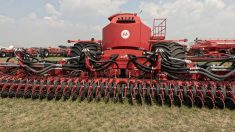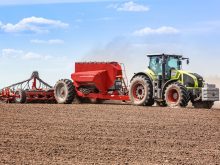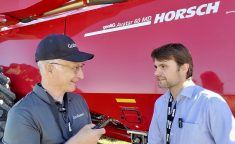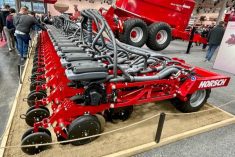[UPDATED: Oct. 26, 2021] It seems virtually every ag machinery brand is currently taking a serious look at building autonomous technology into their equipment. Even brands you might not have expected such development from. For example, Regina-based SeedMaster had been known only as a seeding implement manufacturer until it unveiled DOT, an autonomous seeding robot.
Now, another company, Germany-based Horsch, known in North America for its tillage equipment, has announced it too is partnering with Trimble to develop autonomy for its equipment line.
Read Also

Claas brings 1000 Series SP forage harvesters to Canada
In mid-August, Claas unveiled its new line of Jaguar forage harvesters at an event in Visalia, California, deep in the heart of that state’s dairy region.
“The unique opportunity with this collaboration is not that we are presenting a future utopia but that we are moving step-by-step toward autonomy in a pragmatic, consistent manner,” said Theo Leeb, managing director for Horsch.
The April announcement came with a tantalizing hint of what’s to come as Horsch released an image of a concept robotic machine wearing the brand’s name and traditional red livery, but it didn’t provide much in the way of technical details on it.
According to the company, the idea of creating a fully autonomous machine started in the early 2000s when the brand initially experimented with auto guidance.
“When it worked, we immediately thought if something like this works, we should also be able to drive completely autonomously,” said Michael Horsch in a press release. “But at that time, the project came to nothing. When we bought our test farm, AgroVation, in the Czech Republic, we had the chance to focus on CTF (controlled traffic farming) and track planning. We originally started with an agronomic point of view, but we soon realized that CTF first and foremost is about planning. This was another step towards autonomous driving systems.”
Horsch believes the next generation of farmers are more than ready for autonomous machines, given the general level of technology in society today. And not only are they ready for it, they expect it.
“The time of the generation — that, by the way, I also belong to — that is into fully air-conditioned cabins and a showy bonnet is coming to an end,” he said. “The next generation is already waiting in the wings, is 14 to 18 years old, and digitally native. The ability to deal with touchscreens, smartphones and tablets is almost innate. These young people control everything that moves completely intuitively and without ever having read a user manual. The users are already there. We have to meet the requirements.”
Horsch expects to continue to work on autonomous projects and says it expects to be able to talk about further developments on that front before too long.
*Update: The article previously mentioned Raven Industries. We apologize for the error and any confusion it caused.















